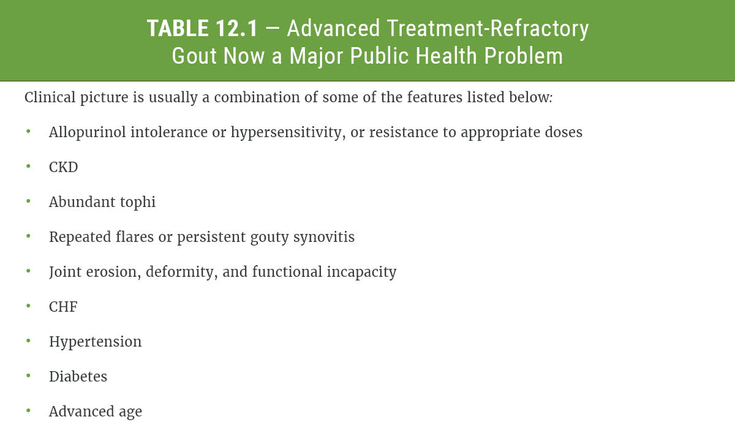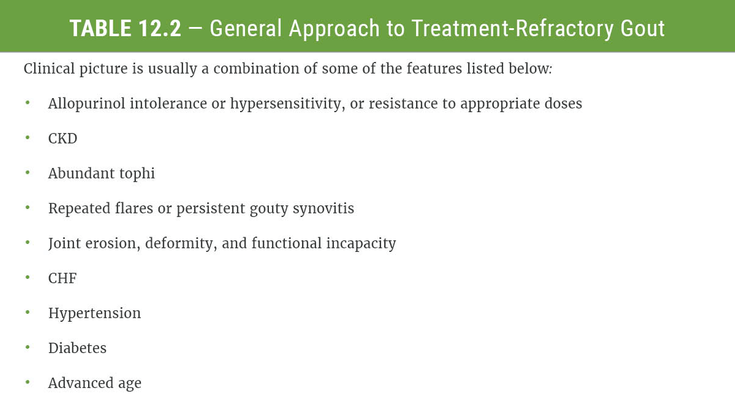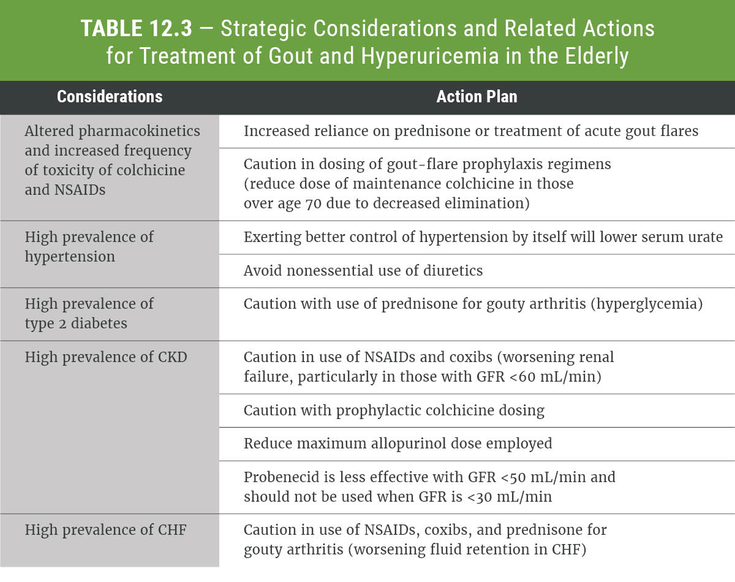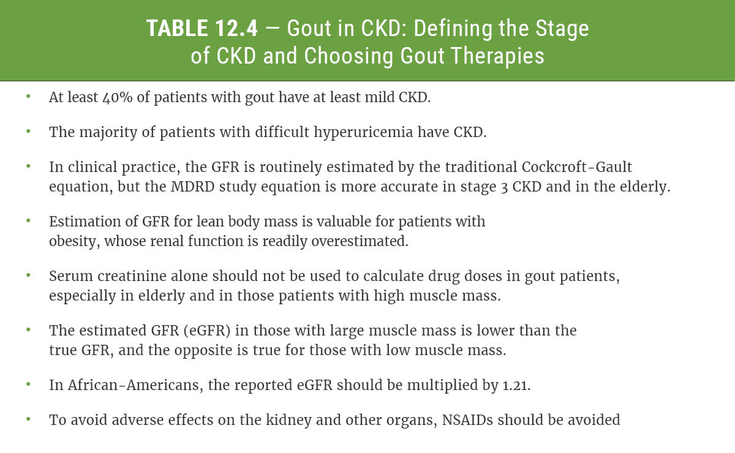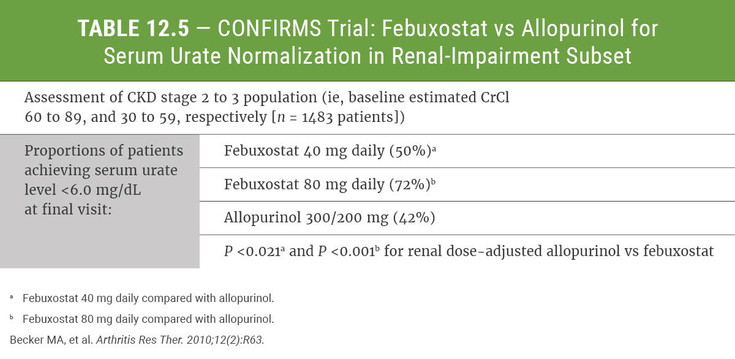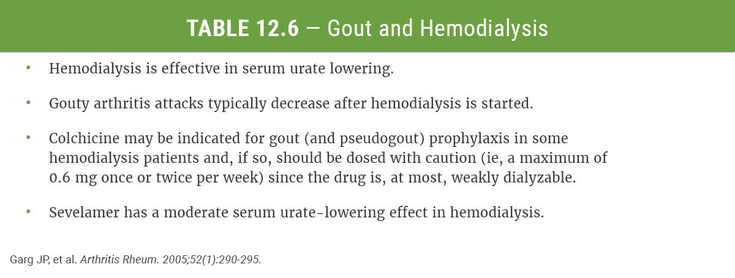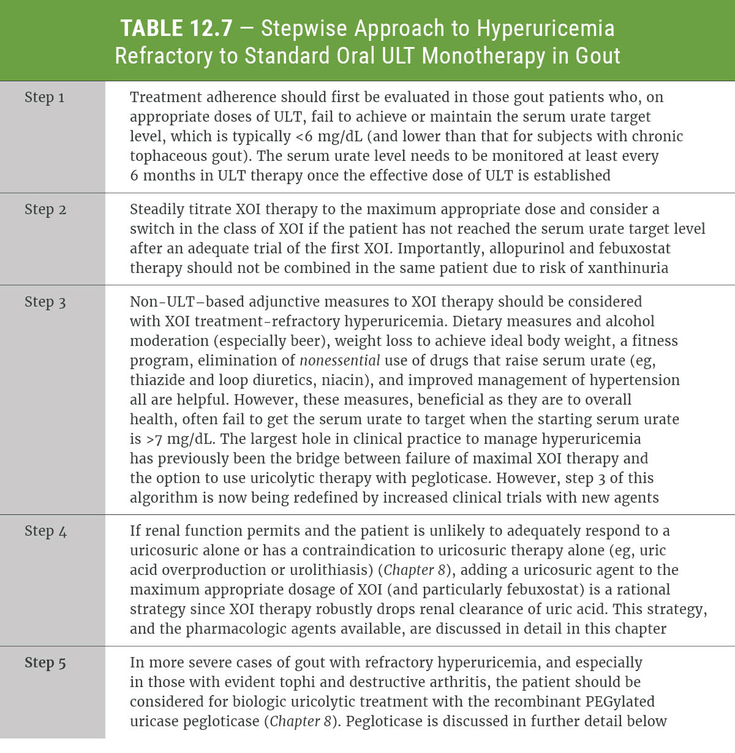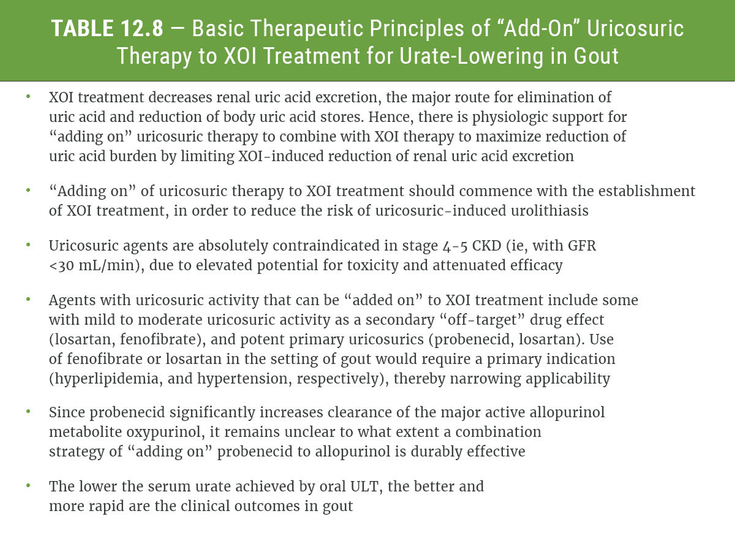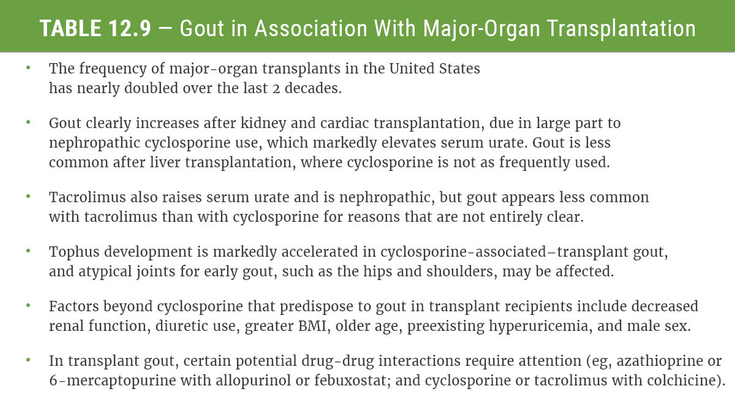Difficult Gout and Hyperuricemia
Therapeutic Strategies and Options
Over the years, gout has grown in clinical complexity. We see many more cases with iatrogenic factors, multiple comorbidities, advanced age and treatment-refractory hyperuricemia and arthritis (Table 12-1). Clinicians need systematic approaches to treatment-refractory gouty arthritis and tophaceous disease (particularly with erosive, destructive chronic arthritis), including strategies to tackle refractory hyperuricemia not simply due to treatment nonadherence.
General considerations in the treatment of difficult gout and approaches to treatment-refractory disease are summarized in Table 12-2. Core treatment issues in gout patients that present particular problems include advanced age, diabetes, chronic heart failure (CHF), chronic kidney disease (CKD), hemodialysis, and major-organ transplants, as well as refractory gouty arthritis, hyperuricemia and chronic tophaceous arthritis. These issues are discussed here in a practical manner.
To continue reading
Log in or register to continue reading. It's free!
OR
By signing up to create an account, I accept Healio's Terms of Use and Privacy Policy.
Therapeutic Strategies and Options
Over the years, gout has grown in clinical complexity. We see many more cases with iatrogenic factors, multiple comorbidities, advanced age and treatment-refractory hyperuricemia and arthritis (Table 12-1). Clinicians need systematic approaches to treatment-refractory gouty arthritis and tophaceous disease (particularly with erosive, destructive chronic arthritis), including strategies to tackle refractory hyperuricemia not simply due to treatment nonadherence.
General considerations in the treatment of difficult gout and approaches to treatment-refractory disease are summarized in Table 12-2. Core treatment issues in gout patients that present particular problems include advanced age, diabetes, chronic heart failure (CHF), chronic kidney disease (CKD), hemodialysis, and major-organ transplants, as well as refractory gouty arthritis, hyperuricemia and chronic tophaceous arthritis. These issues are discussed here in a practical manner.
Gout in Elderly Individuals
The incidence and prevalence of gout are rising far more quickly in individuals over age 65, and particularly over age 75, than in any other age group (Who Gets Gout?). This makes gout in the elderly a major public health problem. A high proportion of elderly gout patients are women, and ~5% of elderly women (and >7% of elderly men) have gout. In both genders, tophi can deposit in (or mimic) nodal osteoarthritis joints in the hands, which may require joint aspiration and crystal analysis and/or imaging to make the diagnosis of gout.
Elderly patients with gout (more frequently than younger patients) have acute bouts of polyarticular gout, which are often accompanied by fever and leukocytosis. Polyarticular acute gout can be the first manifestation of gout in elderly patients, thereby presenting problems in differential diagnosis (Diagnosis of Gout). Some patients with acute gouty polyarthritis require admission for inpatient treatment. Also, acute polyarticular gout can complicate inpatient admission for another condition; in elderly patients, this is quite often CHF exacerbation during or shortly after intense loop diuretic therapy that promotes intravascular volume depletion with intense rise of serum urate (often to 13-14 mg/dL), followed by marked fall of serum urate. Elderly patients with acute gout also can present with atypical features such as delirium.
Strategic considerations and related action-plan items for treatment of gout and hyperuricemia in the elderly are cited in detail in Table 12-3. It is just as important to treat hyperuricemia effectively in the elderly with gout as it is in younger patients in order to provide long-term decrease in flares and to inhibit progression to advanced disease. However, elderly patients with gout are typically more challenging to manage, due to their high prevalence of comorbidities and polypharmacy.
Gout in Chronic Kidney Disease (CKD)
Defining the Stage of CKD
At least 40% of patients with gout have at least mild CKD (stage 2, defined as glomerular filtration rate [GFR] or creatinine clearance [CrCl] of 60 to 89 mL/min, accompanied by renal abnormalities). The majority of patients with difficult hyperuricemia have CKD, many with stage 3 CKD (defined as GFR 30 to 59 mL/min). Dosages of many drugs eliminated by the kidney are based on renal function calculated as estimated GFR (eGFR), but such calculations are valid only with stable renal function and serum creatinine level. In clinical practice, the GFR is routinely estimated by the traditional Cockcroft-Gault equation, but the Modification of Diet in Renal Disease (MDRD) study equation is more accurate in those with eGFR <60 mL/min per 1.73 m2 and <90 mL/min per 1.73 m2 body surface area in the elderly.
Importantly, serum creatinine alone should not be used to calculate gout-drug doses, especially in the elderly and in those with high muscle mass. The eGFR in those with large muscle mass is lower than the true GFR and the opposite is true for those with low muscle mass. In African Americans, the reported eGFR should be multiplied by 1.21. Estimation of GFR calibrated to lean body mass is valuable for patients with obesity whose renal function is typically overestimated.
ULT and Predominant Role of Xanthine Oxidase Inhibitors (XOI) in Gout Patients With Stage 3 CKD
XOI therapy (e.g., allopurinol and febuxostat), titrated upwards to maximum appropriate dose, serves as the foundation of urate-lowering therapy (ULT) with stage 3-5 CKD, with a uricosuric added to the XOI for refractory hyperuricemia where appropriate. The FDA and EULAR recommendations are to reduce the maximum dose of allopurinol in CKD, a strategy supported by retrospective safety analyses. However, renal dose adjustment of allopurinol does not prevent allopurinol hypersensitivity and it also fails to adequately normalize serum urate in most patients with CKD (Table 12-4). Upward dose titration of allopurinol >300 mg daily has not been systematically studied for safety in those with impaired renal function.
A past pivotal clinical trial comparison of renal dose-adjusted allopurinol (200 to 300 mg daily in stage 2 to 3 CKD) and febuxostat 40 and 80 mg daily in the CONFIRMS trial revealed superiority of febuxostat at these doses, with particular advantage at a dose of febuxostat 80 mg daily (Table 12-5). Renal elimination plays a minor role in disposition of febuxostat, unlike the case for the major active allopurinol metabolite oxypurinol. In clinical trials, febuxostat was studied in stage 2 and 3 CKD; thus the effects of febuxostat on serum urate in those with stage 4 or worse CKD has not yet been evaluated on a larger scale. However, febuxostat clearly is a front-line treatment option in gout patients with CKD.
Several agents with uricosuric activity have efficacy in patients with stage 3 CKD. The potent uricosuric probenecid may be less effective when GFR is from 30-50 mL/min and should not be used at all with GFR <30 mL/min. In stage 3 CKD, there are insufficient data for ULT efficacy of drugs with moderate uricosuric activity, such as fenofibrate and losartan and risk of toxicity of both of these “secondary urate-lowering agents with uricosuric activity” is increased in stage 3 CKD compared to those without renal impairment. Last, uricosuric agents are absolutely contraindicated in stage 4-5 CKD (i.e., with GFR <30 mL/min), due to elevated potential for toxicity and attenuated efficacy.
NSAID and Colchicine Use in Gout Patients With Renal Disease
Potential adverse NSAID effects on the kidney include acute and chronic renal failure, nephrotic syndrome, interstitial nephritis, and the constellation of renal changes termed “analgesic nephropathy.” In gout patients with eGFR<60 mL/min, NSAIDs should be avoided (or used with a high degree of caution) and limited to patients who are adequately hydrated and do not have combined stresses to the renin-angiotensin system (eg, CHF, angiotensin-converting enzyme [ACE] inhibitor or angiotensin II receptor blocker [ARB] treatment, poorly controlled hypertension, ascites, hepatic cirrhosis).
Since the risk of acute and chronic renal dysfunction with NSAIDs (and coxibs) is substantial in those with CKD stage 3 or worse, colchicine is a central tool for prophylaxis of gout flares in CKD (Prophylaxis of Acute Gout Flares). This is particularly the case in those starting ULT. Prophylaxis of Acute Gout Flares presents a conservative set of dosing recommendations for colchicine with different degrees of CKD.
Gout Therapy Considerations in ESRD and Hemodialysis
The prevalence of end-stage renal disease (ESRD) has more than doubled over the last 2 decades. Importantly, hemodialysis significantly reduces total-body urate stores since urate is dialyzable. Moreover, gout flares most commonly lessen in frequency after hemodialysis is initiated, likely also mediated in part by the effects of ESRD and hemodialysis on inflammatory responses. Interestingly, the phosphate-reducing agent sevelamer decreases serum urate in dialysis patients, possibly by effects that include absorption of urate and lessening the effects of secondary hyperparathyroidism on serum urate. If gout-flare prophylaxis is necessary, colchicine needs to be dosed with great caution in CKD (Prophylaxis of Acute Gout Flares) and particularly in those with ESRD and on dialysis (Table 12-6), since the drug is, at most, only weakly dialyzable. Calcium pyrophosphate dihydrate (CPPD) crystal-induced acute arthritis (pseudogout) is a substantial problem in some patients with ESRD who are on dialysis, driven in part by secondary hyperparathyroidism. Therefore, differential diagnosis of gout requires particularly thoughtful consideration in ESRD.
Refractory Acute Gout
Acute gout flares, especially when polyarticular, may fail to respond to standard therapy regimens (Management of Acute Gouty Arthritis). In this scenario, the accuracy of the gout diagnosis should always be reexamined since infectious arthritis, pseudogout, bacterial cellulitis, OA of the first MTP joint, and other forms of arthritis can mimic acute gout and vice versa. In those with truly refractory acute gout, single joints can be aspirated for diagnostic measures and intra-articular glucocorticoid therapy employed. Combination oral glucocorticoid and NSAID therapy is not advised. Those patients with early failure of NSAIDs can be converted to glucocorticoid therapy, and those with failure of oral glucocorticoid therapy can have the glucocorticoid dose increased and the regimen prolonged, including a longer, slower dose-tapering period. Low-dose colchicine prophylactic therapy can be added to glucocorticoid and NSAID therapy, which can help with suppression of rebound gouty inflammation.
IL-1β antagonism is an emerging strategy for refractory arthritis in gouty arthritis and for gout-flare prophylaxis. It is in clinical development as a therapy option in refractory acute gout in renal impairment, where other options are contraindicated or fail (as discussed in Management of Acute Gouty Arthritis). Currently, the only IL-1β antagonist FDA-approved for the acute treatment of gout is canakinumab.
Refractory Hyperuricemia in Management of Chronic Gout
Pharmacologic Urate-Lowering Therapy discusses overall strategy in pharmacologic ULT, and clinical pharmacology issues pertinent to all major individual oral agents. Guidelines, by providing a synopsis of the 2020 ACR Guidelines for Management of Gout, also spells out recent consensus on approaches to initiation and titration and optimization to target of ULT. This sectionfocuses on core additional advice on management of ULT in patients that fail to achieve target serum urate on standard of care oral ULT monotherapy with an XOI drug (Table 12-7).
In treatment-refractory hyperuricemia, it is critical that treatment adherence first be evaluated in those gout patients who, on appropriate doses of ULT, fail to achieve or maintain the serum urate target level, which is typically <6 mg/dL (and lower than that for patients with chronic tophaceous gout). The serum urate level needs to be monitored at least every 6 months in ULT therapy once the effective dose of ULT is established. In patients refractory to allopurinol, a serum trough oxypurinol level can be drawn, which may indicate that the patient is not taking allopurinol, or may reveal a serum level below the therapeutic range of ~5-15 micrograms per mL (~30-100 μmol/L). In some patients, including many with CKD, a serum oxypurinol level significantly above the therapeutic range may be necessary for optimum therapeutic effect of allopurinol, but adequate studies on correlation of adverse events to dosing to such oxypurinol levels have not yet been done.
Uricosuric “Add-On” Therapy to XOI Treatment of Refractory Hyperuricemia in Nontophaceous and Tophaceous Gout
“Add-on” uricosuric therapy to XOI treatment (by combining allopurinol with probenecid) was advocated by gout experts for tophaceous disease in the 1960s, but was not systematically studied and fell out of favor for unclear reasons. XOI treatment decreases renal uric acid excretion, the major route for elimination of uric acid and reduction of body uric acid stores. Hence, there is support in a physiologic sense, for the concept of adding on uricosuric therapy to combine with XOI therapy to maximize reduction of uric acid burden by limiting XOI-induced reduction of renal uric acid excretion. Adding on of uricosuric therapy to XOI treatment is best commenced by the establishment of XOI treatment, in order to reduce the risk of uricosuric-induced urolithiasis (Table 12-8). The uricosuric add-on to XOI therapy strategy was “rediscovered” in 2007 in a very small, pilot clinical trial, where probenecid added to allopurinol successfully lowered serum urate to target in the majority of nonresponders. Since probenecid increases clearance of the major active allopurinol metabolite oxypurinol, it remains unclear to what extent a combination strategy of adding on probenecid to allopurinol is durably effective, compared to the strategy of adding on probenecid to febuxostat, whose renal clearance is minimal.
Addition to XOI therapy of fenofibrate or losartan (both of which have mild-moderate uricosuric effects) has been explored, as cited in Pharmacologic Urate-Lowering Therapy. Losartan uricosuric activity peaks at a dose of 50 mg/day and the maximal expected reduction in serum urate is ~10% and this effect can be transitory. Fenofibrate appears to be a more potent uricosuric than losartan, but there have not been adequate longer-term, controlled studies of either losartan or fenofibrate, for the extent of synergy with XOI treatment in urate-lowering, or of the clinical impact (on outcomes such as flare rate and tophus resolution) of such combination therapy. Moreover, the use of fenofibrate or losartan in the setting of gout would require a primary indication (hyperlipidemia and hypertension, respectively), thereby narrowing applicability.
Investigational Oral Agents for Treatment Refractory Hyperuricemia in Gout
RDEA3170 is a potent uricosuric in clinical trials for use as add-on uricosuric therapy to XOI therapy for ULT. Some clinical development efforts also have been focused on single agents with combined uricosuric and XOI effects and sustained release febuxostat.
Arhalofenate is a uricosuric (via suppression of URAT1) and also has PPARg receptor agonist-mediated anti-inflammatory effects, as cited in Prophylaxis of Acute Gout Flares. Arhalofenate is in clinical development for uses that include add-on therapy to febuxostat treatment in refractory hyperuricemia in gout. In a 12-week phase 2b, randomized, double-blind controlled clinical trial of arhalofenate vs allopurinol monotherapy (started at 300 mg/day), 800 mg daily arhalofenate lowered serum urate by ~16%, and also significantly decreased gout flare frequency when compared to allopurinol 300 mg/day alone, and compared to placebo alone. However, arhalofenate has not an received FDA approved to date.
Intravenous Biologic Pegloticase Therapy in Treatment-Refractory Chronic Gout
In extension studies of clinical trials, effective oral XOI or uricosuric therapy that reaches and sustains a serum urate target level of <6 mg/dL has been established to ultimately improve the rate of flares and ameliorate QOL outcomes, but the effects on tophus dissolution are generally slow (taking more than 1 year and usually several years or more, for responders to totally resolve their palpable tophi). More rapid tophus dissolution with oral ULT can be achieved by reaching a lower serum urate target (<4 mg/dL) (Pharmacologic Urate-Lowering Therapy). However, this is not always readily achievable with currently FDA-approved oral treatment regimens. Furthermore, functional impairment and decrease in QOL are substantial in chronic, tophaceous gouty arthritis and anatomic joint destruction can be extensive in chronic tophaceous arthropathy.
Uricase therapy a “biologic” approach originally employed primarily for tumor lysis syndrome prevention and treatment, is a valuable option in management of refractory chronic gout. Particular candidates for such therapy are those with palpable tophi, indicative of a very high body uric acid burden. Some of these patients have chronic tophaceous inflammatory synovitis, which can be polyarticular and particularly deforming and debilitating. An important finding of collective studies has been that good responders demonstrate accelerated resolution of tophi using uricase. In pilot studies of off-label use of the non-PEGylated recombinant fungal enzyme rasburicase in chronic gout, urate-lowering effects were substantial in early therapy. Nevertheless, the immunogenicity of the non-PEGylated uricase was associated with lack of sustained efficacy or tolerance in most subjects beyond 6 to 12 months. Rasburicase treatment is neither FDA approved nor recommended for gout.
All uricase proteins are seen by the human immune system as foreign antigens. PEGylation of uricase inhibits (but does not attenuate) antigenicity and markedly increases circulating half-life to many days rather than <24 hours for rasburicase. Phase 3 clinical trials were done for IV PEGylated recombinant porcine-baboon uricase (pegloticase) treatment in 212 subjects with particularly severe gout (ie, ~70% of subjects with visible tophi). A regimen of 8-mg pegloticase every 2 weeks achieved a target serum urate of <6 mg/dL at 6 months in ~42% of patients (by ITT analysis). This dosing arm of the trials also achieved complete resolution of one or more visible tophi in 20% by 13 weeks and ~40% by 25 weeks (Figure 12-1). Subjects on the every-2-week schedule also had a reduction in gout flare incidence by 4 to 6 months, as well as improved physical function, pain and QOL.
Pegloticase was approved by the FDA in 2010 to be used in patients whose gout is recalcitrant to conventional therapies or have large tophaceous deposits leading to loss of function or decreased QOL. Pegloticase appears to provide disease modification in nearly half of these severe cases and the improvement in health related quality of life is remarkable in drug responders, in this refractory and severely affected gout subpopulation. Limitations of pegloticase therapy include treatment-emergent antibodies, which are associated with both infusion-related reactions (IRs) and loss of urate-lowering effect. However, the RECIPE trial provided evidence that efficacy of pegloticase can be improved by adding the immunosuppressor mycophenolate mofetil to the regimen. The MIRROR trial corroborated this finding, demonstrating that the addition of the immunomodulatory drug methotrexate to the pegloticase regimen leads to a significantly greater preservation of the urate-lowering effect, as week as numerically lower development of anti-pegloticase antibodies.
The pegloticase phase 3 clinical trial data have been combined with post hoc analyses to derive a “cessation rule” for the uricase therapy course, based on assay of serum urate sUA prior to each pegloticase infusion, with rise of serum urate to >6.0 mg/dL indicating loss of urate-lowering efficacy and being the indication to stop the course of uricase infusions. In this analysis, it was determined that 91% of all pegloticase infusion reactions occurred in patients with preinfusion serum urate >6.0 mg/dL. This “pegloticase cessation rule” is highly effective in limiting pegloticase infusion reactions and requires that patients be off all potent urate-lowering drugs during the course of their pegloticase infusions.
Early gout flares, likely due to inflammatory changes in tophus architecture, are also substantial in pegloticase therapy. G6PD deficiency is an exclusion criterion for uricase treatment due to the risk of drug-induced methemoglobinemia and hemolysis. Overall, the clinical rate of marked response for pegloticase as a biologic compares favorably to the benchmarks for marked clinical response used to evaluate biologics use in RA, another clinical setting in which the biologic is added after failure of oral first-line therapy, with attendant “refractoriness” of the treatment population. In addition, pegloticase retreatment also was shown in an open-label extension study to provide additional benefits overall in those who have stopped or interrupted treatment but were initially responders to the drug. Pegloticase promotes healing of bone erosions due to gout. Moreover, tophus size reduction using DECT imaging is seen within a span of a few months even in many subjects who ultimately lose pegloticase responsiveness after a few months due to treatment-emergent antibodies to the drug (Figure 12-2 and Figure 12-3). Longer-term safety data for pegloticase, to date, have been acceptable, including for renal function. Therefore, pegloticase provides an advanced treatment option for severe, debilitating cases of chronic tophaceous gout refractory to conventional current therapy. The controlled QOL analyses support such use of pegloticase therapy for specific circumstances, since chronic tophaceous gout is so incapacitating.



Gout in Association With Major Organ Transplantation
The frequency of major organ transplants in the United States has nearly doubled over the last 2 decades (from 25,000 transplants in 2003 to 46,000 in 2023), in part due to better donor networks (Table 12-9). Gout clearly increases after kidney and cardiac transplantation, due in large part to nephropathic calcineurin-inhibitor regimens and, in particular, the marked rise of serum urate promoted by the immune suppressant cyclosporine. The potent inhibition of renal uric acid excretion by cyclosporine is reminiscent of the effects of lead on the renal uric acid elimination. The alternative calcineurin inhibitor tacrolimus also raises serum urate and is nephropathic, but gout appears less common with tacrolimus than with cyclosporine for reasons that are not entirely clear.
In some series of renal transplant–associated gout, the typical serum urate level was ~12 mg/dL. In patients on cyclosporine-based regimens, hyperuricemia develops in up to ~80% and gout incidence ranges as high as 13% to 27% after a period of several years. Tophus development is markedly accelerated (ie, occurs over a few years as opposed to a decade in individuals observed for the natural course of garden-variety gout in middle age). Joints such as the hips and shoulders may be affected early in the course of transplant gout, whereas such joints are only affected clinically in the most severe cases of gout not associated with transplants.
Factors beyond cyclosporine that predispose to gout in transplant recipients include decreased renal function, diuretic use, greater BMI, older age, preexisting hyperuricemia and male sex. The use of particularly high doses of daily cyclosporine (~5 mg/kg) in some cardiac-transplant immune suppression regimens to protect the heart from rejection is a substantial clinical problem. Contrast this with liver-transplant recipients, in whom gout is uncommon, largely due to immune-suppression regimens that do not as often include cyclosporine. Sirolimus (rapamycin) use by physicians managing renal transplants can help in managing gout, since sirolimus does not promote nephropathy or hyperuricemia in the manner of cyclosporine. However, sirolimus has its own set of potential adverse events and there is greater experience with cyclosporine in preventing transplant rejection, the highest priority in these patients.
Treatment and prophylaxis of gouty arthritis and hyperuricemia in major organ transplantation require attention to certain potential drug-drug interactions. It is advisable to consult a rheumatologist for help in managing transplant-associated gout. The metabolism of both azathioprine and 6-mercaptopurine is decreased by allopurinol and potentially by febuxostat and such combinations should be avoided or, if absolutely necessary, a 50% dose reduction of azathioprine and 6-mercaptopurine is a good starting point. Colchicine metabolism is markedly interfered with by cyclosporine, and colchicine myopathy can develop as soon as a few weeks into use of such a drug combination. Use of prophylactic maintenance colchicine in those on cyclosporine, if absolutely indicated, requires ~two thirds dose reduction of colchicine. Tacrolimus, whose metabolism involves CYP3A4 and P-gp (as does that of cyclosporine), also has the potential to decrease colchicine elimination, but specific drug-drug interaction studies to define dosing recommendations have not been performed.
The foundation for ULT in transplant-gout patients on cyclosporine is initial optimization of oral XOI therapy, but the marked hyperuricemia often present in association with CKD may render challenging the treatment to a serum urate target of, at a minimum, <6.0 mg/dL. Combination XOI and uricosuric therapy can be used in some cases, when not limited by renal impairment. There is evidence suggesting that pegloticase immunogenicity is decreased by some immune suppression regimens used in major organ transplantation. Management of acute gout flares and chronic synovitis, which are commonly polyarticular in transplant-gout patients on cyclosporine, also is challenging in the face of CKD and potential drug-drug interactions.
A striking observation is that many patients with transplant gout have substantial acute and chronic gouty arthritis despite being on maintenance doses of prednisone in the range of 5 to 15 mg daily. This observation underscores the aforementioned concern about the lack of evidence basis for low-dose prednisone prophylaxis of gout flares and the need for prednisone or prednisolone starting doses of >0.5 mg/kg daily (typically in divided doses) for effective management of acute gout flares. In transplant-associated acute gout, a primary strategy is to temporarily increase the prednisone or methylprednisolone dose and to establish a safe and effective low-dose colchicine dosing regimen for gout-flare prophylaxis since rebound flares can occur when glucocorticoids are tapered down. ACTH may not be an effective alternative for acute gout when chronic adrenal suppression has developed in well-established low-dose glucocorticoid therapy.
Take-Away Messages
- Gout has grown more prevalent and we have accumulated many more cases with difficult management problems.
- Gout in elderly individuals is difficult to manage and requires as much effort to achieve effective lowering of serum urate as in younger patients.
- Acute gout flares, especially when polyarticular, may fail to respond to standard therapy regimens. In this scenario, the accuracy of the gout diagnosis should always be reexamined.
- The keys to managing gout with CKD are to accurately define the stage of CKD and eGFR rather than always using serum creatinine to do so.
- Many uricosuric agents, including probenecid, lose efficacy in patients with stage 3 CKD and uricosurics are contraindicated in stage 4-5 CKD. Thus XOI therapy serves as the foundation of ULT with CKD of stage 3-5 CKD.
- FDA and EULAR recommendations are to reduce the maximum dose of allopurinol in CKD.
- Renal-dose adjustment of allopurinol does not prevent allopurinol hypersensitivity and it also fails to adequately normalize serum urate in most patients with CKD.
- A comparison of renal dose-adjusted allopurinol (200 to 300 mg daily in stage 2 to 3 CKD) and febuxostat 40 mg and 80 mg daily in the CONFIRMS trial revealed superiority of febuxostat at these doses, with particular advantage of febuxostat at 80 mg daily.
- In gout patients with eGFR <60 mL/min, NSAIDs should be avoided (or used with a high degree of caution) and limited to patients who are adequately hydrated and do not have other stresses to the renin-angiotensin system.
- Since the risk of acute and chronic renal dysfunction with NSAIDs (and coxibs) is substantial in those with CKD stage 3 or worse, colchicine (with renal function and potential drug interaction based dose adjustment) is a central tool for prophylaxis of gout flares in CKD.
- Gout flares most commonly lessen in frequency after hemodialysis is initiated in ESRD.
- Serum urate needs to be monitored at least every 6 months in ULT once the effective dose of ULT is established.
- The “adding on” of potent uricosuric therapy to a XOI-based ULT regimen has significant efficacy in managing refractory hyperuricemia in gout.
- In more severe cases of gout with refractory hyperuricemia, pegloticase should be considered, especially with a high body uric acid burden evidenced by palpable tophi. Pre-infusion monitoring of plasma urate (to screen for loss of therapeutic effect) is strongly predictive of those with substantial treatment-emergent antibodies and thereby helps markedly limit the incidence of infusion-related reactions to pegloticase.
- Gout markedly increases after major organ transplantation, due in large part to nephropathic-calcineurin inhibitor regimens and, in particular, the marked rise of serum urate promoted by the immune suppressant cyclosporine.
- Treatment and prophylaxis of gouty arthritis and of hyperuricemia in major organ transplantation requires attention to potentially severe drug-drug interactions (including XOI therapy with azathioprine and 6-mercatopurine and colchicine with cyclosporine).
- Patients with transplant gout can have substantial acute and chronic gouty arthritis despite being on maintenance doses of prednisone in the range of 5 to 15 mg daily.
References
- Terkeltaub R, Edwards NL, Khanna P. Gout: Diagnosis and Management of Gouty Arthritis and Hyperuricemia. 5th ed. Professional Communications Inc. 2024
- Abbott KC, Kimmel PL, Dharnidharka V, Oglesby RJ, Agodoa LY, Caillard S. New-onset gout after kidney transplantation: incidence, risk factors and implications. Transplantation. 2005;80(10):1383-1391.


